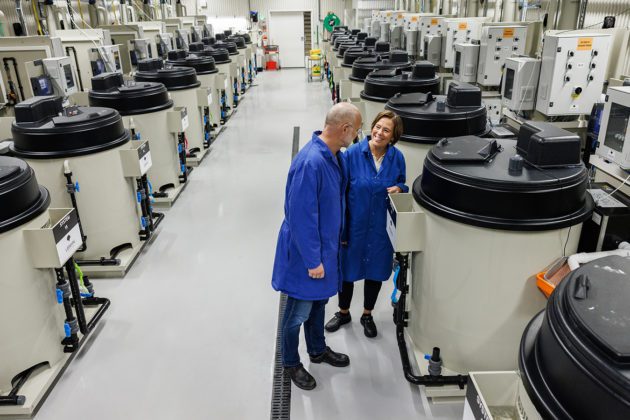
Features
Research
post-smolt
Ongoing research on post-smolt
December 11, 2023 By Matt Jones
 Single-RAS units at Nofima at Sunndalsøra. (Image: Terje Aamodt/Nofima)
Single-RAS units at Nofima at Sunndalsøra. (Image: Terje Aamodt/Nofima) Post-smolt growing, where fish are raised on land before being transferred to a sea pen to finish their maturation, has become increasingly popular over the past decade.
However, while the technique makes a great deal of sense – that giving the fish more time to grow in a controlled environment would make them more resilient to some of the stressors that they will encounter in the sea – those benefits have not been scientifically proven yet.
Moreover, as Norwegian Institute of Food, Fisheries and Aquaculture Research (Nofima) Senior Researcher Trine Ytrestøyl explains, there are some challenges with mortalities when the fish are transferred to the sea pens that are the subject of ongoing research.
“We did a survey that had a question about how they rated the performance of these larger smolts in seawater,” says Ytrestøyl. “In Norway, this is kind of a new operation to move large smolts into seawater pens after keeping them on land – there’s not so many producers yet that are going beyond around 300 grams, but its increasing. But the majority said that the performance of this larger smolt could be poorer than smaller smolt. And in trials we have seen this as well. There seems to be some issues that are not resolved about why these bigger smolts have more issues related to mortality and also, in growth during the first period in seawater.”
Ytrestøyl is quick to note that these findings are very preliminary and far from comprehensive. As noted, post-smolt growing is still a fairly new approach in Norway, and there is a significant amount of variation between the species that are being raised, the logistics of land-based RAS systems, and the conditions in the sea where the fish are being kept. Given all those variables, it is entirely too early to draw conclusions and more focused research is required.
“The problem is the way the smolts are produced are quite diverse in Norway,” says Ytrestøyl. “Some give them a winter signal, some do not. Salinity may vary between freshwater up to 22 ppt. Some give them feed to induce modification. There’s so many different protocols that it’s difficult to say which one is the best one.”
One of the theories which seems to hold the most water – no pun intended – is that temperature differences could be a significant factor. Ytrestøyl observes that Norway has a long coast with a variety of different temperatures, which then also lead to a variety of different conditions for parasites and other pressures.
“You have so many factors, it’s difficult to pinpoint which is giving the bigger smolt problems,” says Ytrestøyl. “And of course, the infrastructure is dimensioned for a smaller fish. So is it really optimal when you want to transport and pump a fish up to one kilo? It’s a new kind of production and it’s evolving quite fast.”
A summary of the Nofima survey does include some general recommendations, citing that a temperature of 10-12 C is recommended to ensure good growth in seawater and to reduce early sexual maturation in male fish. The use of a winter signal to induce smoltification is recommended to ensure seawater tolerance and performance. Water velocity should be around 1.0-1.2 body lengths per second. And a salinity of 12-15 ppt has been shown to give optimal growth in several studies and is considered to cause fewer problems with skin health and wound formation.
“But it is uncertain whether 12-15 ppt is sufficient to maintain seawater tolerance in large smolts,” says the summary. “It is recommended that the fish is acclimatized to the sea temperature so that the change in temperature is a maximum of 3-5 C, and transfer of large smolts at cold water temperatures is not recommended. Several breeders experience challenges with fish welfare if the density exceeds 65-70 kg/m3 and the majority believe that 65 kg/m3 is a good limit value that safeguards water quality and fish health.”
However, while Ytrestøyl and NOFIMA stand by those recommendations, there is so much variability in the different techniques and conditions both in RAS and in the sea pens that more research will be necessary before specific causes and solutions are identified. But that research is not merely being driven by academics – the industry themselves are heavily involved in exploring the challenges and potential solutions.
“It’s a huge job to find the optimal environment for fish,” says Ytrestøyl. “We are, of course, not near finding the right answer, but it’s a continuous process. And it’s important, because we have to get the mortality numbers down because they are too high.”
Print this page